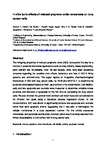In vitro toxic effects of reduced graphene oxide nanosheets on lung cancer cells
| dc.contributor.author | Tabish, TA | |
| dc.contributor.author | Pranjol, MZI | |
| dc.contributor.author | Hayat, H | |
| dc.contributor.author | Rahat, Alma | |
| dc.contributor.author | Abdullah, TM | |
| dc.contributor.author | Whatmore, JL | |
| dc.contributor.author | Zhang, S | |
| dc.date.accessioned | 2019-03-15T21:39:01Z | |
| dc.date.available | 2019-03-15T21:39:01Z | |
| dc.date.issued | 2017-12-15 | |
| dc.identifier.issn | 0957-4484 | |
| dc.identifier.issn | 1361-6528 | |
| dc.identifier.other | 504001 | |
| dc.identifier.uri | http://hdl.handle.net/10026.1/13480 | |
| dc.description | journal_title: Nanotechnology article_type: paper article_title: toxic effects of reduced graphene oxide nanosheets on lung cancer cells copyright_information: © 2017 IOP Publishing Ltd date_received: 2017-08-30 date_accepted: 2017-10-24 date_epub: 2017-11-21 | |
| dc.description.abstract |
The intriguing properties of reduced graphene oxide (rGO) have paved the way for a number of potential biomedical applications such as drug delivery, tissue engineering, gene delivery and bio-sensing. Over the last decade, there have been escalating concerns regarding the possible toxic effects, behaviour and fate of rGO in living systems and environments. This paper reports on integrative chemical-biological interactions of rGO with lung cancer cells, i.e. A549 and SKMES-1, to determine its potential toxicological impacts on them, as a function of its concentration. Cell viability, early and late apoptosis and necrosis were measured to determine oxidative stress potential, and induction of apoptosis for the first time by comparing two lung cancer cells. We also showed the general trend between cell death rates and concentrations for different cell types using a Gaussian process regression model. At low concentrations, rGO was shown to significantly produce late apoptosis and necrosis rather than early apoptotic events, suggesting that it was able to disintegrate the cellular membranes in a dose dependent manner. For the toxicity exposures undertaken, late apoptosis and necrosis occurred, which was most likely resultant from limited bioavailability of unmodified rGO in lung cancer cells. | |
| dc.format.extent | 504001-504001 | |
| dc.format.medium | ||
| dc.language | eng | |
| dc.language.iso | en | |
| dc.publisher | IOP Publishing | |
| dc.subject | necrosis | |
| dc.subject | apoptosis | |
| dc.subject | toxicity | |
| dc.subject | cell viability | |
| dc.subject | reduced graphene oxide nanosheets | |
| dc.title | In vitro toxic effects of reduced graphene oxide nanosheets on lung cancer cells | |
| dc.type | journal-article | |
| dc.type | Journal Article | |
| plymouth.author-url | https://www.webofscience.com/api/gateway?GWVersion=2&SrcApp=PARTNER_APP&SrcAuth=LinksAMR&KeyUT=WOS:000415957400001&DestLinkType=FullRecord&DestApp=ALL_WOS&UsrCustomerID=11bb513d99f797142bcfeffcc58ea008 | |
| plymouth.issue | 50 | |
| plymouth.volume | 28 | |
| plymouth.publication-status | Published | |
| plymouth.journal | Nanotechnology | |
| dc.identifier.doi | 10.1088/1361-6528/aa95a8 | |
| plymouth.organisational-group | /Plymouth | |
| plymouth.organisational-group | /Plymouth/Faculty of Science and Engineering | |
| plymouth.organisational-group | /Plymouth/REF 2021 Researchers by UoA | |
| plymouth.organisational-group | /Plymouth/REF 2021 Researchers by UoA/UoA11 Computer Science and Informatics | |
| dc.publisher.place | England | |
| dcterms.dateAccepted | 2017-10-24 | |
| dc.identifier.eissn | 1361-6528 | |
| dc.rights.embargoperiod | Not known | |
| rioxxterms.versionofrecord | 10.1088/1361-6528/aa95a8 | |
| rioxxterms.licenseref.uri | http://www.rioxx.net/licenses/all-rights-reserved | |
| rioxxterms.licenseref.startdate | 2017-12-15 | |
| rioxxterms.type | Journal Article/Review | |
| atmire.cua.enabled |


